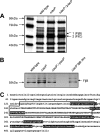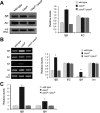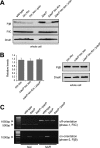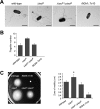Effect of iacP mutation on flagellar phase variation in Salmonella enterica serovar typhimurium strain UK-1
- PMID: 22685287
- PMCID: PMC3416257
- DOI: 10.1128/JB.00076-12
Effect of iacP mutation on flagellar phase variation in Salmonella enterica serovar typhimurium strain UK-1
Abstract
Flagella are surface appendages that are important for bacterial motility and invasion of host cells. Two flagellin subunits in Salmonella enterica serovar Typhimurium, FliC and FljB, are alternatively expressed by a site-specific DNA inversion mechanism called flagellar phase variation. Although this inversion mechanism is understood at the molecular level, the key factor controlling the expression of the two flagellin subunits has not been determined. In this study, we found that a putative acyl carrier protein, IacP, affects flagellar phase variation in S. Typhimurium strain UK-1 under Salmonella pathogenicity island 1 (SPI1)-inducing conditions. Liquid chromatography-mass spectrometry analysis of the secreted proteins from S. Typhimurium determined that the amount of FljB secreted was significantly higher in the iacP mutant strain, a finding confirmed by Western blot analysis. Northern blotting, quantitative PCR, and microarray data showed that the level of FljB in the iacP mutant strain was regulated at the transcriptional level, although the transcription and expression of the fliC gene were independent of IacP. FljB production was abolished by the deletion of the Hin DNA invertase but could be restored by the introduction of a plasmid carrying the hin gene. We also found that in the iacP mutant strain, the orientation of the invertible H segment is in the FljB-expressing phase. Furthermore, electron microscopy observations indicated that the iacP mutant strain had more flagella per cell than the wild-type strain. These results suggest that IacP is associated with flagellar phase switching under SPI1-inducing conditions.
Figures






Similar articles
-
Salmonella Regulator STM0347 Mediates Flagellar Phase Variation via Hin Invertase.Int J Mol Sci. 2022 Jul 30;23(15):8481. doi: 10.3390/ijms23158481. Int J Mol Sci. 2022. PMID: 35955615 Free PMC article.
-
Enhancement of host immune responses by oral vaccination to Salmonella enterica serovar Typhimurium harboring both FliC and FljB flagella.PLoS One. 2013 Sep 17;8(9):e74850. doi: 10.1371/journal.pone.0074850. eCollection 2013. PLoS One. 2013. PMID: 24069357 Free PMC article.
-
Two DNA invertases contribute to flagellar phase variation in Salmonella enterica serovar Typhimurium strain LT2.J Bacteriol. 2006 Feb;188(3):950-7. doi: 10.1128/JB.188.3.950-957.2006. J Bacteriol. 2006. PMID: 16428399 Free PMC article.
-
Characterization of a monoclonal antibody directed against Salmonella enterica serovar Typhimurium and serovar [4,5,12:i:-].Appl Environ Microbiol. 2009 Mar;75(5):1345-54. doi: 10.1128/AEM.01597-08. Epub 2009 Jan 5. Appl Environ Microbiol. 2009. PMID: 19124586 Free PMC article.
-
[Salmonella multiphasic flagellar antigen].Postepy Hig Med Dosw (Online). 2012 Jun 26;66:446-51. doi: 10.5604/17322693.1001631. Postepy Hig Med Dosw (Online). 2012. PMID: 22922144 Review. Polish.
Cited by
-
The Burkholderia pseudomallei Proteins BapA and BapC Are Secreted TTSS3 Effectors and BapB Levels Modulate Expression of BopE.PLoS One. 2015 Dec 1;10(12):e0143916. doi: 10.1371/journal.pone.0143916. eCollection 2015. PLoS One. 2015. PMID: 26624293 Free PMC article.
-
The Bacterial iprA Gene Is Conserved across Enterobacteriaceae, Is Involved in Oxidative Stress Resistance, and Influences Gene Expression in Salmonella enterica Serovar Typhimurium.J Bacteriol. 2016 Jul 28;198(16):2166-79. doi: 10.1128/JB.00144-16. Print 2016 Aug 15. J Bacteriol. 2016. PMID: 27246569 Free PMC article.
-
Posttranslational maturation of the invasion acyl carrier protein of Salmonella enterica serovar Typhimurium requires an essential phosphopantetheinyl transferase of the fatty acid biosynthesis pathway.J Bacteriol. 2013 Oct;195(19):4399-405. doi: 10.1128/JB.00472-13. Epub 2013 Jul 26. J Bacteriol. 2013. PMID: 23893113 Free PMC article.
-
Salmonella Regulator STM0347 Mediates Flagellar Phase Variation via Hin Invertase.Int J Mol Sci. 2022 Jul 30;23(15):8481. doi: 10.3390/ijms23158481. Int J Mol Sci. 2022. PMID: 35955615 Free PMC article.
-
Enhancement of host immune responses by oral vaccination to Salmonella enterica serovar Typhimurium harboring both FliC and FljB flagella.PLoS One. 2013 Sep 17;8(9):e74850. doi: 10.1371/journal.pone.0074850. eCollection 2013. PLoS One. 2013. PMID: 24069357 Free PMC article.
References
-
- Blair DF. 1995. How bacteria sense and swim. Annu. Rev. Microbiol. 49: 489–522 - PubMed
-
- Byers DM, Gong H. 2007. Acyl carrier protein: structure-function relationships in a conserved multifunctional protein family. Biochem. Cell Biol. 85: 649–662 - PubMed
-
- Davis RW, Botstein D, Roth JR, Cold Spring Harbor Laboratory 1980. Advanced bacterial genetics. Cold Spring Harbor Laboratory, Cold Spring Harbor, NY
Publication types
MeSH terms
Substances
LinkOut - more resources
Full Text Sources
Molecular Biology Databases

